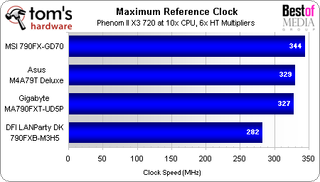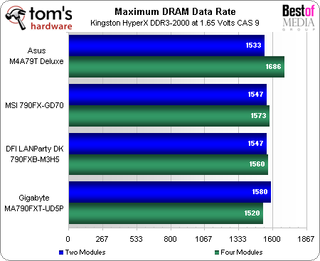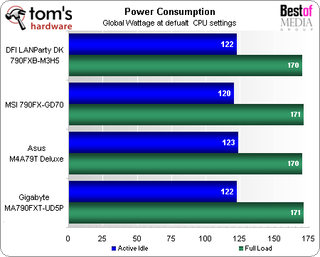Roundup: Four 790FX Socket AM3 Motherboards
Overclocking, Power, And Heat
All of the motherboards in today’s comparison provide frequency ranges that exceed by far any realistic expectations of stability and most voltage ceilings are far beyond any realistic expectations of reliability. Experienced overclockers know not to shoot for the limit at first, but instead determine the maximum supported speed and required voltage by making small changes and retesting repeatedly.
| BIOS Frequency And Voltage Settings (For Overclocking) | ||||
|---|---|---|---|---|
| Asus M4A79T Deluxe | DFI LANParty DK 790FXB-M3H5 | Gigabyte MA790FXT-UD5P | MSI 790FX-GD70 | |
| CPU Ref Clock | 200-600 MHz (1 MHz) | 200-700 MHz (1 MHz) | 200-500 MHz (1 MHz) | 200-600 MHz (1 MHz) |
| CPU Multiplier | Yes | Yes | Yes | Yes |
| DRAM Data Rates | 800/1066/1333/1600 | 800/1066/1333/1600 | 800/1066/1333/1600 | 800/1066/1333/1600 |
| PCIe Clock | 100-150 MHz (1 MHz) | 100-250 MHz (1 MHz) | 100-200 MHz (1 MHz) | 100-150 MHz (1 MHz) |
| CPU Vcore | 0.80-1.70V (0.0125V) | -800-+775mv (25mv) | +25-600mV (25mV) | 0.98-1.93V (0.01V) |
| IMC Voltage | 0.80-1.55V (0.0125V) | +3.57, 7.14, 10.71% | +25-600mV (25mV) | 0.85-1.83V (0.01V) |
| 790FX Core | 1.10-1.40V (0.02V) | 1.12-1.50V (0.04V) | +0.1, +0.2, +0.3 V | 0.75-1.83V (0.01V) |
| SB750 Core | 1.20-1.35V (0.15V) | 1.20-1.50V (0.20V) | +0.1, +0.2, +0.3 V | 0.85-1.83V (0.01V) |
| DRAM Voltage | 1.50-2.50V (0.02V) | 1.50-2.49V (0.22V) | +50-750mV (50mV) | 1.19-2.40V (0.01V) |
| CAS Latency | 4-12 Cycles | 4-11 Cycles | 4-12 Cycles | 4-12 Cycles |
| RAS To CAS Delay | 5-12 Cycles | 5-11 Cycles | 5-12 Cycles | 5-12 Cycles |
| Row Precharge | 5-12 Cycles | 5-11 Cycles | 5-12 Cycles | 5-12 Cycles |
| tRAS | 15-30 Cycles | 16-30 Cycles | 15-30 Cycles | 15-30 Cycles |
The two boards with the “smallest” CPU voltage regulators also have the most aggressive voltage levels, but we limited our CPU core to 1.45 V to assure longevity.

The two motherboards with 10-phase power regulation finished first and last, with Gigabyte providing the highest stable CPU clock at our chosen voltage levels.

MSI has the best reference clock stability. A combination of first-place reference clock and second-place CPU stability could make the 790FX-GD70 a top overclocking choice for multiplier-locked processors.

Dropping timings all the way back to 9-9-9-28 at 2T wasn’t enough to get most configurations beyond DDR3-1600, though Asus did break that barrier with four modules installed.

The two five-phase power regulators placed first and last in thermal performance. MSI’s win is probably due to its enormous VRM sink.

All of today’s motherboards appear energy efficient, yet none stand apart. Chipset and CPU manufacturer AMD gets all the credit for an overall good showing.
Stay on the Cutting Edge
Join the experts who read Tom's Hardware for the inside track on enthusiast PC tech news — and have for over 25 years. We'll send breaking news and in-depth reviews of CPUs, GPUs, AI, maker hardware and more straight to your inbox.
Current page: Overclocking, Power, And Heat
Prev Page Benchmark Results: Synthetic Next Page Conclusion-
NitroSuperSonic AMD Phenom II X3 720 Black EditionReply
(2.80 GHz, 86.0 MB Cache)
I never knew any AMD processors had that much cache! -
judeh101 NitroSuperSonicAMD Phenom II X3 720 Black Edition(2.80 GHz, 86.0 MB Cache)I never knew any AMD processors had that much cache!Reply
Super CPU! -
ifko_pifko "Asus has clear performance leadership,..." :-)))Reply
1.66% better than the worst performer in the tests. :-) -
tacoslave who said Phenom II has low cache size i think with those 86mb you can do amazing things!!Reply -
tacoslave sorry about the double post but i would have liked to have seen these benchmarked with two 4870x2's... since they keep talking about them so much.Reply -
cangelini Super CPU fixed ;)Reply
Not much point in throwing that much GPU horsepower at a motherboard review; the card Thomas used is our current reference--and it's more than ample for showcasing the differences between these boards.
If you want to see quad-CrossFire for any specific reason, feel free to let us know and we can put together a story idea! -
EQPlayer I think people would like to see a dual-295/dual-4870x2 series of benches if only for the "OMG BEASTLY!" factor. I dunno. XDReply -
Crashman ifko_pifko"Asus has clear performance leadership,..." :-)))1.66% better than the worst performer in the tests. :-)Reply
Consistent would have been better if not for the fear of people pointing out ever tiny inconsistency. Just remember, if you're 5'11" tall it's clear to just about everyone that you're not 6'!!! -
Proximon cangelini...the card Thomas used is our current reference--and it's more than ample for showcasing the differences between these boards.Reply
Could you clarify that a bit Chris? Are you saying you would not expect any difference in crossfire between the MBs? If so, that's OK. However, if there's going to be a difference, that is the main reason to buy a 790FX. If you aren't going to crossfire might as well get a GX.
I suspect the chipset isn't the whole story and the various manufacturers could still screw up the PCI-E voltages or something :p
Most Popular


